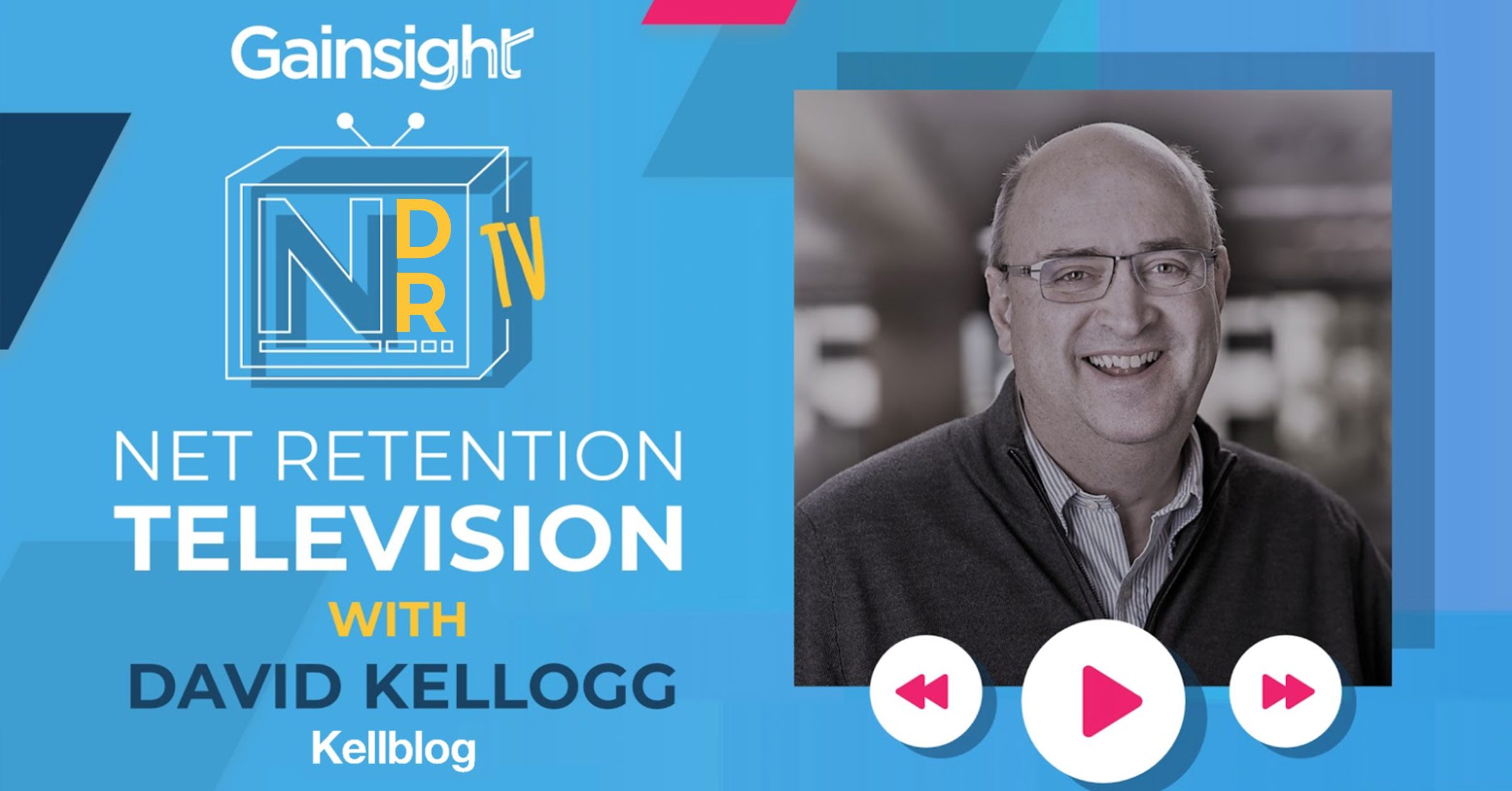This month Gainsight launched NDR tv with our first guest, Dave Kellogg. Interestingly, there were not just the nuggets of wisdom abound, but an atmosphere of a kindred passion for all things CS and the hot topic of net dollar retention (NDR). And as Nick said, “the most important metric in customer success has shifted from churn to net retention.”
Nick declared Dave as his “SaaS soulmate.” Knowing Nick’s breadth of knowledge, his stature in the CS world, and the fact that he is a true unicorn in our industry, your curiosity had to be piqued. Dave is just as unique, with a career history of over ten years in each position as CEO, CMO, and independent director across a range of companies diverse in their revenue size of up to $1B.
1. Doing the Math
Dave is a self-proclaimed “math guy” to the bone. And his attention to customer success and churn is long and legendary. Dave started the moment he recognized the truth behind the formula: Churn X Customer Acquisition Cost (CAC) = the actual dollar cost of churn. The day I realized that,” Dave said, “I went, wait a minute. If we churned $2 million and our CAC ratio is 1.7, I just spent $3.4 million. I’m going to have to spend $3.4 million to find new annual recurring revenue (ARR) to fill the leakage.”
The stark fact surrounding the dollar amount brought the reality home for him. Dave explained that when using percentages, it sterilizes the amount from having a more significant impact. Personalize it! Saying 8% is acceptable is not as stark of truth as saying your company churned $2 Million and you’re going to spend $3.4 Million on sales and marketing to backfill. It dawned on Dave, “What if we spent some fraction of that $3.4 million in not losing them [customers] in the first place?”
The next piece of wisdom Dave shared was the CAC perspective. To Dave, it’s simply how much a company will spend to acquire a new dollar of ARR, typically calculated by last quarter’s sales and marketing expense divided by the next quarter’s new ARR. But the tricky question is, “How much did it cost you to buy that ARR dollar?” For SaaS companies, it’s all about recurring revenue. If you can spend less on retention than on the acquisition of new customers, then do it!
2. Churn is a Form of Marketing
Another Golden Nugget Dave gave was how churn affects marketing. Most of his tech background took place before his tenure in marketing. In marketing, Dave found the best asset is word of mouth (also known as customer advocacy). Regarding churn, the math doesn’t even consider the word of mouth damage done by the cost of churned customers. Word of mouth is a huge boost and buying factor in tech. In most communities, people ask their friends and colleagues how they’re solving pain points and problems. Each churn dollar leaking out runs conjointly with a person who may not say nice things about you or your company when their friends call asking for advice. So, churn not only affects ARR, it can impact marketing spend, as well.
3. Questionable Calculations
Dave brought up a fascinating subject—the calculation of churn in relation to lifetime value. Sometimes the process is questionable. If you have a 90% retention rate, you have a 10% churn rate. But is that calculated against a ten-year lifetime value or one year? “The underlying point is it’s crazy for a three-year-old company to say they have a ten-year customer lifetime. It is inherently questionable.” That is when Dave introduced the concept of how the renewal date fits into the formula.
Companies with multi-year contracts have to choose between figuring the churn rate by available to renew (ATR) or annual recurring revenue (ARR) because only a fraction of their base is up for renewal. If you state you have 10% churn, but only 20% of your base is up for renewal and only have a small percentage renewed, the actual churn number is much larger. Another issue to consider is how your ARR is distributed across segments. For example, are your enterprise sales backlogged? Then, undoubtedly, your renewal will reflect that too.
Nick echoed that when he explained about a company that said, “The good news is our churn rate is one percent a year. The bad news is we have three-year contracts, and we started selling two and a half years ago. Yeah, nobody has come up for renewal yet.” It becomes a game. That is why churn isn’t as accurate nor valuable for insight as NDR.
4. Gaming the System
Dave discussed more issues about “gaming the system.” One case is called “Survivorship Bias.” An idea that originated in mutual funds involves shutting down the bad funds and marketing the returns on the surviving good ones. In CS, some people use the same survivor bias process. They look at current customers and then go back to compare what they were worth a year ago.
By only counting the survivors and then going backward, they exclude the people or customers who chose to no longer do business with them. Their retention rate is vastly different than what it should be. Accurate churn rates should be based on available ARR to renew each quarter and then measure the churn against the ATR. Nick noted that this practice of “Survivorship Bias” breaks the whole concept of net retention. A rare gold nugget!
5. CSMs Collaborating With Sales
In the past, Dave shared that the focus for most companies was on minimizing gross churn. Now, the focus needs to be on net dollar expansion or retention. The reason? “I want my customer success department driving towards optimizing the value of the installed base and not towards minimizing mistakes,” Dave said. Unfortunately, the mindset has been a reactive or defensive one within most CS teams and organizations where they try to prevent customer loss at all costs. For Dave, that leads to dysfunctional behavior. The mission isn’t to “save every customer, even if maybe they shouldn’t be saved.”
6. Who Owns Retention, Renewals, and Upsells
Who then should be responsible for retention, renewals, and upsells? Dave said it very plainly, “Of all the models I’ve heard of, the one I like best is where our customer success manager owns a cohort of customers, and their job is to make that cohort grow.” As an example, the focus should be to increase the value of that cohort from $100,000 last year to $120,000 this year. “And I think it gives you the right incentives because they can say this one [customer] is not worth saving, and that one is worth expanding.” Dave went on to share that he favors a model where CSMs collaborate with sales.
Nick agreed that alignment between CS and sales was critical. “I think that CS needs to move to a world where we all are accountable for results,” Nick explained. “And that’s not bad. That’s good for customers because you’re driving things that hopefully are helping them.” Dave agreed, sharing that that process includes two upsell models. The first version is called an incidental upsell, or as Dave said, “Fries with your burger.” “It’s upgrading. In addition, it’s selling more seats. It’s doing a price increase. Those are all in effect ‘fries with your burger’ sales.”
The second model is at the other extreme as a wholesale cycle upsell. The process is different where the existing customer almost has a new buyer persona. There are different motions, including a full evaluation. “I don’t want to put a CSM in on what’s effectively a new sale to a new buyer, to existing customers,” Dave said. “So I would call that a full sale cycle, not an incidental upsell.” The rule and driving principle for him was using the “hunter-farmer” cliche. “Let’s not put our farmers against their hunters. It could end badly.”
For many companies, this is a shift in thinking about churn and moving to an NDR framework. Next month, on May 19, Tomasz Tunguz, Managing Director at Redpoint Ventures, will join us live on our Linkedin page. To get a deeper understanding of how we are thinking about this metric internally at Gainsight, join us for our four-part NDR masterclass.
Full session recording:

